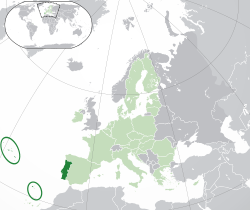
Back جمهورية البرتغال الثالثة Arabic Tercer República Portuguesa AST Dritte Portugiesische Republik German Tercera República portuguesa Spanish Troisième République (Portugal) French Terceira República Portuguesa Galician तीसरा पुर्तगाली गणराज्य Hindi ポルトガル第三共和政 Japanese Terceira República Portuguesa Portuguese Tredje portugisiska republiken Swedish
Portuguese Republic República Portuguesa (Portuguese) | |
|---|---|
| Anthem: "A Portuguesa" "The Portuguese" | |
 Location of Portugal (dark green) – in Europe (green & dark grey) | |
| Capital and largest city | Lisbon 38°46′N 9°9′W / 38.767°N 9.150°W |
| Official languages | Portuguese |
| Recognised regional languages | Mirandese[note 1] |
| Nationality (2022)[3] |
|
| Religion (2021)[4] |
|
| Demonym(s) | Portuguese |
| Government | Unitary semi-presidential constitutional republic[5] |
| Marcelo Rebelo de Sousa | |
| Luís Montenegro | |
| Legislature | Assembly of the Republic |
| Establishment | |
• County | 868 |
| 24 June 1128 | |
• Kingdom | 25 July 1139 |
| 5 October 1143 | |
| 23 September 1822 | |
• Republic | 5 October 1910 |
| 25 April 1974 | |
| 25 April 1976[a] | |
| 1 January 1986 | |
| Area | |
• Total | 92,212 km2 (35,603 sq mi)[7] (109th) |
• Water (%) | 1.2 (2015)[6] |
| Population | |
• 2023 estimate | |
• 2021 census | |
• Density | 115.4/km2 (298.9/sq mi) |
| GDP (PPP) | 2024 estimate |
• Total | |
• Per capita | |
| GDP (nominal) | 2024 estimate |
• Total | |
• Per capita | |
| Gini (2023) | medium inequality |
| HDI (2022) | very high (42nd) |
| Currency | Euro (€) (EUR) |
| Time zone | UTC (WET) UTC−1 (Atlantic/Azores) |
• Summer (DST) | UTC+1 (WEST) UTC (Atlantic/Azores) |
| Note: Continental Portugal and Madeira use WET/WEST; the Azores are 1 hour behind. | |
| Date format | dd/mm/yyyy |
| Drives on | Right |
| Calling code | +351 |
| ISO 3166 code | PT |
| Internet TLD | .pt |
| |
| History of Portugal |
|---|
 |
| Timeline |
|
|
The Third Portuguese Republic (Portuguese: Terceira República Portuguesa) is a period in the history of Portugal corresponding to the current democratic regime installed after the Carnation Revolution of 25 April 1974, that put an end to the paternal autocratic regime of Estado Novo of António de Oliveira Salazar and Marcelo Caetano. It was initially characterized by constant instability and was threatened by the possibility of a civil war during the early post-revolutionary years. A new constitution was drafted, censorship was prohibited, free speech declared, political prisoners were released and major Estado Novo institutions were closed. Eventually the country granted independence to its African colonies and began a process of democratization that led to the accession of Portugal to the EEC (today's European Union) in 1986.
- ^ a b "Reconhecimento oficial de direitos linguísticos da comunidade mirandesa (Official recognition of linguistic rights of the Mirandese community)". Centro de Linguística da Universidade de Lisboa (UdL). Archived from the original on 18 March 2002. Retrieved 2 December 2015.
- ^ a b The Euromosaic study, Mirandese in Portugal, europa.eu – European Commission website. Retrieved January 2007. Link updated December 2015
- ^ "SEF - Serviço de Estrangeiros e Fronteiras". Portal Serviço de Estrangeiros e Fronteiras. Archived from the original on 13 August 2023. Retrieved 1 August 2023.
- ^ "Censos 2021. Católicos diminuem, mas ainda são mais de 80% dos portugueses". RTP. 23 November 2022. Retrieved 23 November 2022.
- ^ Constitution of Portugal, Preamble:
- ^ "Surface water and surface water change". Organisation for Economic Co-operation and Development (OECD). Retrieved 11 October 2020.
- ^ (in Portuguese)"Superfície Que municípios têm maior e menor área?". Pordata. Retrieved 17 November 2020.
- ^ "População residente ultrapassa os 10,6 milhões - 2023". ine.pt. INE. Retrieved 18 June 2024.
- ^ "Censos 2021 - Principais tendências ocorridas em Portugal na última década". Statistics Portugal - Web Portal. 23 November 2022. Archived from the original on 23 November 2022. Retrieved 23 November 2022.
- ^ a b c d "World Economic Outlook Database, April 2024 Edition. (Portugal)". www.imf.org. International Monetary Fund. 16 April 2024. Retrieved 16 April 2024.
- ^ "A taxa de risco de pobreza aumentou para 17,0% em 2022 - 2023". www.ine.pt. INE. Retrieved 12 February 2024.
- ^ "Human Development Report 2023/24" (PDF). United Nations Development Programme. 13 March 2024. p. 288. Retrieved 13 March 2024.
Cite error: There are <ref group=note> tags on this page, but the references will not show without a {{reflist|group=note}} template (see the help page).
Cite error: There are <ref group=lower-alpha> tags or {{efn}} templates on this page, but the references will not show without a {{reflist|group=lower-alpha}} template or {{notelist}} template (see the help page).

